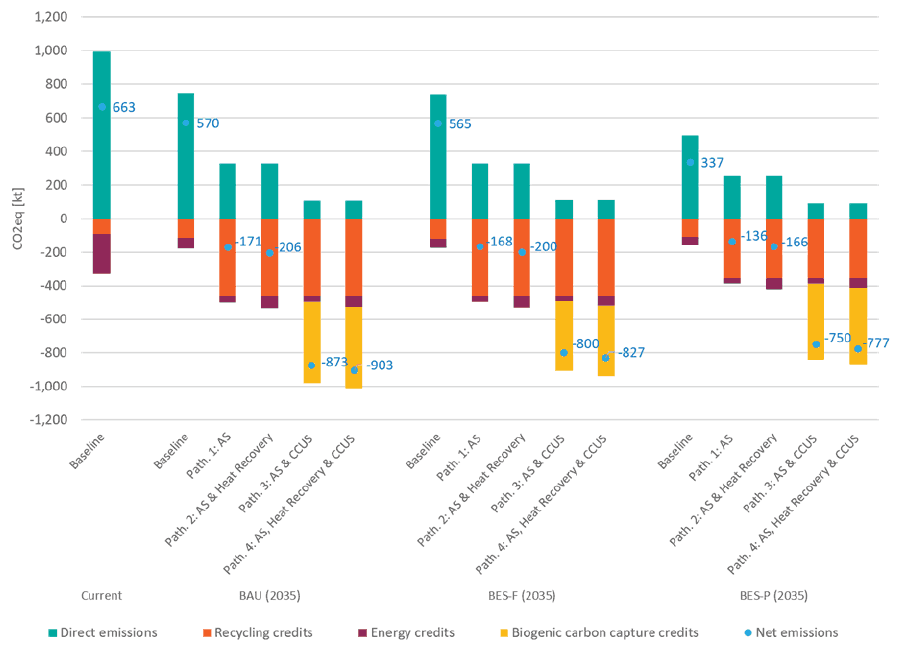Decarbonisation of residual waste infrastructure: report
Second report and supporting documents from the Independent Review of the Role of Incineration in the Waste Hierarchy in Scotland (Stop, Sort, Burn, Bury?), on decarbonisation of residual waste infrastructure in Scotland.
5 Eunomia Report Results
This section summarises the results from the Eunomia report[71]. These results are also integrated into the discussions above.
5.1 Eunomia Report Results – Overall
The Eunomia report provides a substantial amount of information on how the modelled pathways would affect decarbonisation of incineration in Scotland in each of the three scenarios. This is summarised in Figure 4.

There are four types of impact on emissions that emerge from this work:
1. Direct emissions from the incinerator (teal)
2. ‘Recycling credits’ – emissions avoided by using recycled materials rather than virgin ones (orange)
3. ‘Energy credits’ – emissions avoided by displacing other forms of energy generation (heat and/or electricity) (dark pink)
4. ‘Biogenic carbon capture credits’ – the allowance for burning biogenic waste and then capturing the short-cycle GHGs that are then emitted (yellow)
As discussed in Section 3.2.1, none of these currently score as waste sector emissions and only the first type is generally reported (under energy). However, when considering the resource and waste management system as a whole, and when seeking to reach a net zero and more circular economy, they are clearly relevant to enable policy makers to take fully-informed decisions. This is made even more clear by Figure 5, which shows the emissions associated with the production of materials that eventually become the waste that has to be treated, alongside the waste treatment impacts. When such impacts are included, all the scenarios for all the pathways have a net contribution to climate change. End-of-life benefits arising from techniques like CCUS therefore need to be seen in the wider waste and resources systems context.

In all three scenarios and all pathways, the modelling makes an allowance for energy credits. For the baseline and Pathways 1 and 3 this is from electricity generation (29-61ktCO2e) and for Pathways 2 and 4 both electricity and heat (56-72ktCO2e).
5.2 Eunomia Report Results – Advanced Sorting
Removing most of the recyclable plastic from incinerator feedstock via advanced sorting has a substantial and immediate impact on direct emissions as summarised in Table 2. There are also significant (355-463ktCO2e) recycling credits across the three scenarios from advanced sorting.
| 2035 Scenario | Modelled Direct Emissions ktCO2e | |||
|---|---|---|---|---|
| Baseline | + AS | Reduction | ||
| BAU | 747 | 329 | 418 | 56% |
| BES-F | 741 | 328 | 413 | 56% |
| BES-P | 496 | 252 | 244 | 49% |
This strongly supports the argument that implementation of advanced sorting, along with other measures to avoid plastic waste being incinerated (such as waste prevention and better source segregation as set out in Section 4.3) is a vital decarbonisation solution for incineration. In addition, unlike the other options examined, this is applicable to all current and potential incineration facilities, irrespective of location or technology.
5.3 Eunomia Report Results – CCUS
The Eunomia work also indicates that the application of CCUS could deliver substantial carbon savings by capturing fossil GHG emissions (Table 3), based on the optimistic deployment assumptions used.
| 2035 Scenario | Modelled Direct Emissions ktCO2e | ||||
|---|---|---|---|---|---|
| Baseline | + AS | + CCUS | Reduction | ||
| BAU | 747 | 329 | 106 | 641 | 86% |
| BES-F | 741 | 328 | 110 | 631 | 85% |
| BES-P* | 496 | 252 | 90 | 406 | 82% |
*The savings in scenario BES-P are lower because this scenario assumes less plastic is in the residual waste due to upstream policies.
In addition to the recycling credits described above, CCUS could also deliver biogenic carbon capture credits. These are also potentially significant (417-482ktCO2e), though again accounting for them is not currently straightforward.
However, as Section 4.7 sets out, the barriers to deployment of CCUS are considerable, so these reductions are a best case scenario by 2035 that depends on a number of things falling into place. These results underpin the Review’s position that CCUS should continue to be pursued because of its significant potential, but it cannot be relied upon to decarbonise incineration quickly enough to meet Scotland’s ambitions.
5.4 Eunomia Report Results – Heat Networks
Using excess heat from incinerators for other users has a relatively small impact (and once more is not strictly attributed to the waste sector). This supports and confirms the Review’s position that the deployment of heat networks is unlikely to be a major element in incinerator decarbonisation, though it can still play a useful role in improving the overall efficiency of the facilities that are connected in this way.
Contact
Email: zero_waste_inbox@gov.scot
There is a problem
Thanks for your feedback